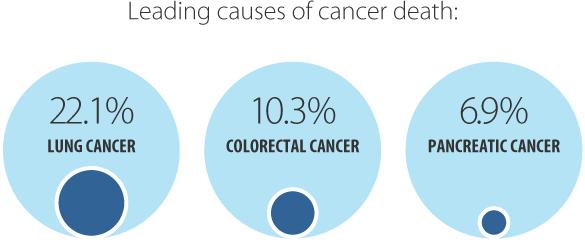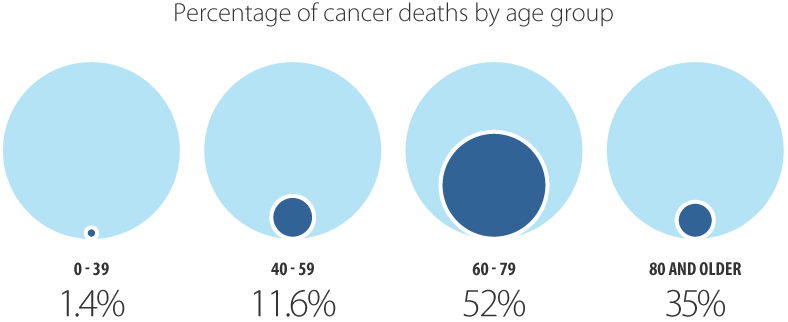
Ontario Cancer Statistics 2022 Ch 2: Estimated Current Cancer Mortality
Mortality measures the number of deaths caused by cancer. This chapter reports projections for 2019 to 2022. The projected statistics do not account for the effects of the COVID-19 pandemic.
What's on this page
Mortality Overview
While the number of deaths (mortality) from all cancers in Ontario has increased over the past 3 decades, the mortality rate has decreased. ln general, cancer mortality is affected by:
- cancer incidence
- cancer survival
- socio-demographic factors
- the availability and effectiveness of early detection and screening for cancer
- the availability of and access to effective treatment for cancer
ln 2022, an estimated 31,196 people in Ontario are expected to die from cancer (excluding non-melanoma skin cancer). This estimate represents an age-standardized mortality rate of 174.9 out of every 100,000 people (Figure 2.1). While the number of cancer deaths has increased each year since 1984, the age-standardized mortality rate peaked in 1988 and has decreased every year since 1999.
Mortality by Sex

Among males, cancer is expected to cause 16,392 deaths in 2022, which will result in an age-standardized mortality rate of 204.0 per 100,000 (Figure 2.2). The numbers are expected to be lower for females, with 14,804 expected deaths and an age-standardized mortality rate of 152.7 per 100,000. Males are projected to account for 52% of all cancer deaths in 2022. This percentage has decreased slightly over time, with males accounting for 54% of all cancer deaths in 1984.
Mortality by Cancer Type
ln 2022, the leading cause of cancer death is expected to be lung cancer, which is projected to account for 22.1% of all cancer deaths (6,908). Colorectal cancer is expected to cause the second highest number of deaths (3,226 or 10.3%), followed by pancreatic cancer. Despite having a much lower incidence, pancreatic cancer is projected to cause roughly the same number of deaths (2,156 or 6.9%) as female breast cancer (2,114 or 6.8%). Together, these 4 cancers will represent almost half of all cancer deaths.
Lung cancer will also be the leading cause of cancer death in males and in females, although the age-standardized mortality rate is projected to be significantly higher in males (42.2 per 100,000) than females (34.7 per 100,000).
For all cancers listed in Table 2.1, except thyroid cancer, the age-standardized mortality rate is expected to be higher in males than females. The higher male mortality rates is due to generally higher incidence rates among males for every cancer that occurs in both males and females. The higher incidence and mortality in males are due to:
- a higher prevalence of risk factors, such as obesity, alcohol and tobacco use [1]
- greater occupational exposure to carcinogens [2,3]
- less use of medical services [4–6]
- the influence of different sex hormones [7]
The biggest differences in cancer mortality between males and females in 2022 are expected to be for:
- Hodgkin lymphoma, as well as larynx, esophageal, oral cavity and pharynx and bladder cancers, which will have a male age-standardized mortality rate that is at least 3 times higher than the female rate
- melanoma, as well as kidney, liver and stomach cancers, which will have a male age-standardized mortality rate that is about twice as high as the female rate

| Cancer type | Males and females combined - deaths |
Males and females combined - ASMR |
Males - deaths |
Males - ASMR |
Females - deaths |
Females - ASMR |
|---|---|---|---|---|---|---|
| All cancers | 31,196 | 174.9 | 16,392 | 204.0 | 14,804 | 152.7 |
| Bladder | 960 | 5.2 | 683 | 8.6 | 277 | 2.7 |
| Brain | 901 | 5.3 | 512 | 6.5 | 389 | 4.3 |
| Breast (female) | n/a | n/a | n/a | n/a | 2,114 | 23.0 |
| Cervix | n/a | n/a | n/a | n/a | 155 | 1.9 |
| Colorectal | 3,226 | 18.2 | 1,773 | 22.3 | 1,453 | 14.7 |
| Esophagus | 929 | 5.2 | 725 | 8.9 | 204 | 2.1 |
| Hodgkin lymphoma | 43 | 0.2 | 29 | 0.4 | 14 | 0.1 |
| Kidney | 652 | 3.7 | 435 | 5.5 | 217 | 2.2 |
| Larynx | 131 | 0.7 | 111 | 1.4 | 20 | 0.2 |
| Leukemia | 1,140 | 6.4 | 637 | 8.0 | 503 | 5.1 |
| Liver | 1,462 | 8.1 | 952 | 11.6 | 510 | 5.2 |
| Lung | 6,908 | 38.0 | 3,477 | 42.2 | 3,431 | 34.7 |
| Melanoma | 568 | 3.2 | 367 | 4.6 | 201 | 2.1 |
| Myeloma | 618 | 3.4 | 350 | 4.3 | 268 | 2.7 |
| Non-Hodgkin lymphoma | 1,204 | 6.7 | 693 | 8.7 | 511 | 5.1 |
| Oral cavity and pharynx | 613 | 3.5 | 452 | 5.6 | 161 | 1.7 |
| Ovary | n/a | n/a | n/a | n/a | 735 | 7.8 |
| Pancreas | 2,156 | 12.0 | 1,129 | 13.9 | 1,027 | 10.3 |
| Prostate | n/a | n/a | 1,697 | 21.6 | n/a | n/a |
| Stomach | 809 | 4.6 | 505 | 6.3 | 304 | 3.2 |
| Testis | n/a | n/a | 15 | 0.2 | n/a | n/a |
| Thyroid | 105 | 0.6 | 50 | 0.6 | 55 | 0.6 |
| Uterus | n/a | n/a | n/a | n/a | 580 | 6.0 |
Abbreviations: ASMR means age-standardized mortality rate; n/a means not applicable.
Note: Rates are per 100,000 and standardized to the age distribution of the 2011 Canadian Standard population.
Analysis by: Surveillance, Ontario Health (Cancer Care Ontario)
Data source: Ontario Cancer Registry (March 2021), Ontario Health (Cancer Care Ontario)
Mortality by Age
ln 2022, the highest cancer mortality rate is expected to be in the 80 and older age group, followed by the 60 to 79 age group. The latter group, however, will account for an estimated 52% of all deaths, compared to 35% for the older age group (Table 2.2).

Deaths from cancer before age 40 will continue to be uncommon in 2022, with only 442 deaths expected. These deaths represent 1.4% of all cancer deaths and a rate of 5.9 deaths per 100,000 people.
Although projected mortality rates increase substantially at ages 60 to 79 for most cancer types, the exceptions are for breast and lung cancers. The rates for these cancers instead begin to increase rapidly in the 40 to 59 age group.
| Cancer type | Ages 0 to 39 Deaths |
Ages 0 to 39 Age-specific rate |
Ages 40 to 59 Deaths |
Ages 40 to 59 Age-specific rate |
Ages 60 to 79 Deaths |
Ages 60 to 79 Age-specific rate |
Age 80 and older Deaths |
Age 80 and older Age-specific rate |
|---|---|---|---|---|---|---|---|---|
| All cancers | 442 | 5.9 | 3,610 | 93.3 | 16,173 | 523.6 | 10,971 | 1,587.5 |
| Bladder | ** | ** | 46 | 1.2 | 414 | 13.4 | 499 | 72.2 |
| Brain | 68 | 0.9 | 201 | 5.2 | 487 | 15.8 | 145 | 21.0 |
| Breast (female) | 69 | 1.9 | 462 | 23.4 | 920 | 57.0 | 663 | 161.6 |
| Cervix | 13 | 0.4 | 56 | 2.8 | 62 | 3.8 | 24 | 5.8 |
| Colorectal | 36 | 0.5 | 391 | 10.1 | 1,500 | 48.6 | 1,299 | 188.0 |
| Esophagus | ** | ** | 129 | 3.3 | 544 | 17.6 | 252 | 36.5 |
| Hodgkin lymphoma | 6 | 0.1 | ** | ** | 22 | 0.7 | 10 | 1.4 |
| Kidney | ** | ** | 78 | 2.0 | 337 | 10.9 | 233 | 33.7 |
| Larynx | ** | ** | 15 | 0.4 | 76 | 2.5 | 40 | 5.8 |
| Leukemia | 40 | 0.5 | 88 | 2.3 | 529 | 17.1 | 483 | 69.9 |
| Liver | 18 | 0.2 | 159 | 4.1 | 874 | 28.3 | 411 | 59.5 |
| Lung | 18 | 0.2 | 587 | 15.2 | 4,220 | 136.6 | 2,083 | 301.4 |
| Melanoma | 22 | 0.3 | 83 | 2.1 | 275 | 8.9 | 188 | 27.2 |
| Myeloma | ** | ** | 52 | 1.3 | 328 | 10.6 | 238 | 34.4 |
| Non-Hodgkin lymphoma | 22 | 0.3 | 127 | 3.3 | 596 | 19.3 | 459 | 66.4 |
| Oral cavity and pharynx | 8 | 0.1 | 117 | 3.0 | 345 | 11.2 | 143 | 20.7 |
| Ovary | 17 | 0.5 | 124 | 6.3 | 401 | 24.8 | 193 | 47.0 |
| Pancreas | 10 | 0.1 | 239 | 6.2 | 1,210 | 39.2 | 697 | 100.9 |
| Prostate | ** | ** | 54 | 2.8 | 717 | 48.6 | 926 | 329.8 |
| Stomach | 9 | 0.1 | 129 | 3.3 | 410 | 13.3 | 261 | 37.8 |
| Testis | 7 | 0.2 | ** | ** | ** | ** | ** | ** |
| Thyroid | ** | ** | 13 | 0.3 | 57 | 1.8 | 35 | 5.1 |
| Uterus | ** | ** | 72 | 3.7 | 346 | 21.4 | 160 | 39.0 |
Symbol: ** Suppressed due to small case count (less than 6).
Note: Rates are per 100,000.
Analysis by: Surveillance, Ontario Health (Cancer Care Ontario)
Data source: Ontario Cancer Registry (March 2021), Ontario Health (Cancer Care Ontario)
For more information on cancer mortality in Ontario, including data on more cancer types and trends over time, see Chapter 5: Cancer Mortality.
